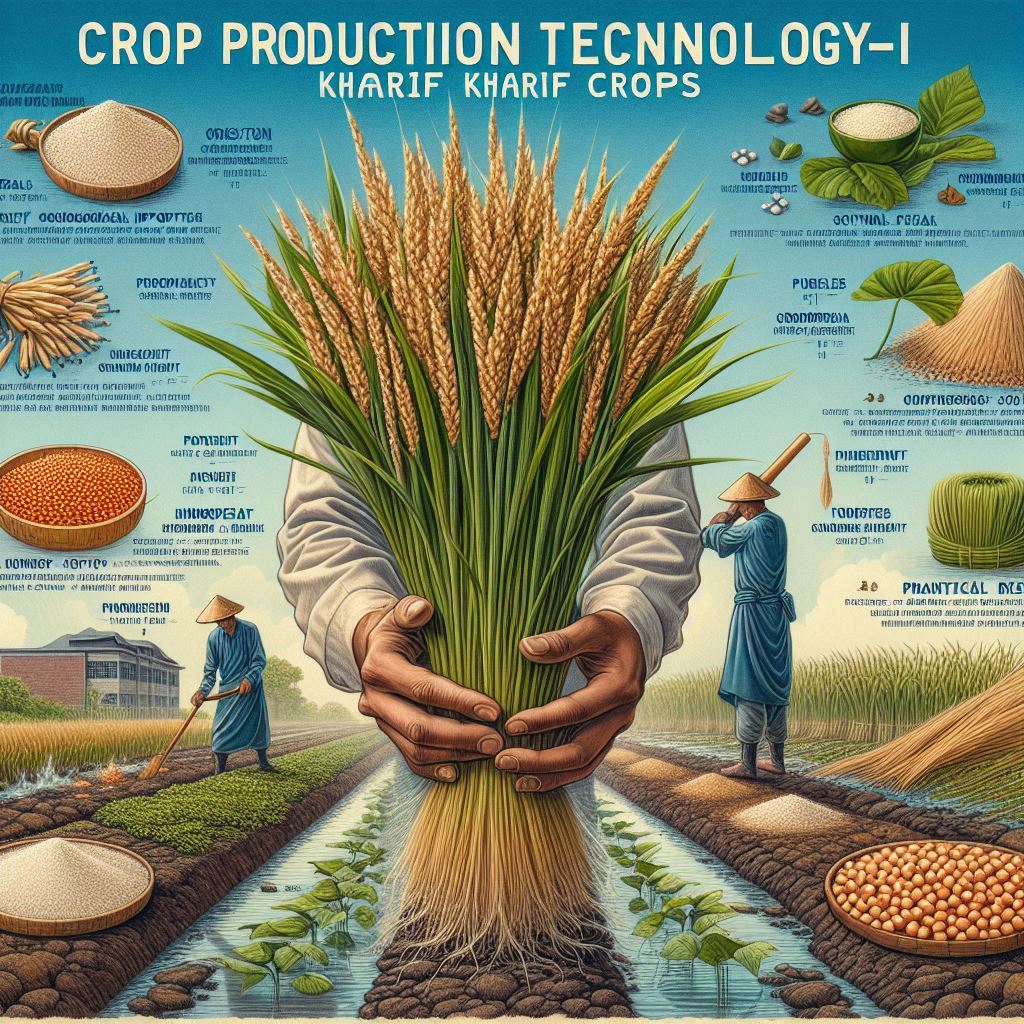AGRON – 211 Crop Production Technology – I (Kharif Crops)]
- SORGHUM – Sorghum bicolor
- Family – Poaceae
- 2n- 20
- Origin place – Africa
Sorghum
- Importance: Most important cereal crop in India.
- Ranking: Second in area (after rice) and third in production (after rice and wheat).
- Cultivation: Grown in both kharif and rabi seasons, contributing to low average yields (864 kg/ha).
- Growing Conditions: Primarily cultivated in marginal lands unsuitable for wheat and maize.
- Global Significance: Major food crop worldwide, alongside wheat, rice, and maize.
- Dependency: Millions in Africa and Asia rely on sorghum as a staple food.
Uses of Sorghum
- Human Food and Animal Feed: Jowar is consumed by both humans and animals.
- Fodder: Used as fodder for livestock.
- Chopped Green Stems: Prepared as hay or silage; also used as pasture.
- Sweet and Pop Sorghum: Eaten directly by humans.
- Jowar Flour: Used to make roti.
- Breweries: Utilized for alcohol production and malting.
- Jowar Cake: Made from fermented dough.
- Sweet Sorghum: Used for syrups and in bakery products.
- Stubbles: Leftover stubbles serve as fuel.
- Tribal Consumption: Tribals consume sorghum grains and sweet stems (10% sugar content).
- Vani Jowar: A specialty from South Gujarat, eaten in green perched conditions.
- Jowar Dhani: Pop sorghum popular among children.
- Animal Feed: Grain fed to cattle, poultry, and swine, in addition to human consumption.
CYANIDE( HCN) : Sorghum varieties and sudan grass produce toxic quantity of cyanide. The cyanide
concentration is highest in seedling stage and declines as the plant grows.
Geographic Distribution of Sorghum
- Global Cultivation: Grown worldwide except in the cool northeastern parts of Europe.
- Sorghum Belts in India: Receive 400-1000 mm of rainfall.
- Major Regions:
- Africa: Nigeria and Sudan are leading producers.
- North America: Significant cultivation.
- South America and Asia: Also grow sorghum.
- India: Primarily cultivated in central and peninsular regions.
Climate
- Sturdiness: Can withstand varied climatic conditions better than most crops.
- Cultivation Areas: Grown successfully in:
- Arid regions of Uttar Pradesh and Rajasthan.
- Humid areas of West Bengal and Bihar.
- Climate: Primarily a tropical warm weather crop.
- Temperature Range: Tolerates temperatures from 15.5 °C to 40.5 °C.
- Rainfall: Thrives with annual rainfall variations of 35-150 cm.
- Elevation: Grows in the plateau region of South India up to 1000 m elevation.
- Photoperiod: A short day plant; flowering and grain formation occur as day length shortens in winter.
Soils and Field Preparation for Sorghum
- Soil Types:
- Grows well in heavy black soils and clay loams.
- Poor performance in gravelly and marshy soils.
- Field Preparation:
- Sorghum is often grown under low input conditions, making soil management crucial for increasing yields.
- Preparation is not as thorough as for other cereals; however, good tilth is essential.
- Land Preparation Steps:
- Ploughing: In black cotton soil areas, ploughing followed by harrowing is practiced if weeds are present.
- Equipment: Use iron or country ploughs; tractor discing or ploughing is advisable.
- Cattle Manure: Apply 12 t/ha and mix with soil through ploughing or harrowing.
- Blade Harrowing: Work land with a blade harrow 2-3 times; sometimes use a gorru without seeding attachment.
Seeds and Sowing Methods
Sorghum can be sown using several methods:
- Broadcasting:
- Description: Seeds are scattered over the soil; not widely used due to high seed rate and uneven distribution.
- Seed Rate: 12-18 kg/ha (less for dry lands).
- Usage: Typically for irrigated lands with beds and channels.
2.Drilling:
- Description: Seeds are sown using seed drills and covered with soil.
- Seed Rate: 8-12 kg/ha; higher for light soils, lower for black soils.
- Spacing: 45×15-20 cm at 3-4 cm depth.
3.Dibbling:
- Description: Seeds are placed in furrows, requiring more labor but using less seed (6 kg/ha).
- Spacing: 45×15 cm; depth of 2.5-5 cm.
- Practice: Common in dry lands; thinning done at 15-20 days after sowing.
4.Transplanting:
- Description: Seedlings from nurseries are planted in furrows.
- Usage: Common in regions with sufficient rainfall; used for hybrid sorghum.
- Benefits: Ensures better establishment; practiced mainly in South India.
5. Ratooning:
- Description: Cultivating a new crop from stubble of the previous crop, avoiding reseeding.
- Suitability: Effective under irrigated conditions; hybrids like CSH-1 are best for ratooning.
- Steps:
- Harvest main crop while leaving 4-6 inches of stubble.
- Irrigate 2 days after harvesting to promote sprouting.
- Apply 60 kg N/ha in two splits (basal and 30 days post ratooning).
- Thin weak sprouts, leaving 2-3 healthy ones per stubble.
- Maintain moisture from boot leaf to grain hardening stage.
- Ratoon crop ready for harvest in 80-85 days.
- Implement plant protection measures as needed.
- Ratooning Advantages: Reduces costs for land preparation and sowing, increases net income when managed well.
Spacing for sorghum: 45×12-15cm
Seed treatment: For control of grain smut disease – treat the seed with sulphur @ 5g/kg seed.
OR With organo mercurial compounds or carbomates @ 2.5g/kg seed. For shoot fly-carbofuran 50 WP@100g/kg seed.
Manures and Fertilizers for Sorghum
Nutrient Requirements:
- Nitrogen (N): Essential for increasing grain yields. Its uptake enhances phosphorus (P) absorption.
- Phosphorus (P): Particularly effective when applied with nitrogen. Increases grain yield significantly.
- Potassium (K): Response to K is infrequent; only apply if there is a known deficiency.
Recommended Fertilizer Doses:
- Rainfed Varieties:
- 25 kg N + 25 kg P₂O₅/ha often yields better results than 50 kg N/ha.
- Irrigated Conditions:
- Apply 40 kg N and 40 kg P₂O₅/ha.
- General Dose for High-Yield Varieties (HYVs):
- 80 kg N, 40 kg P₂O₅, and 20 kg K₂O/ha.
Time and Method of Application
- Fertilizer Application:
- Avoid direct contact with seeds to prevent germination injury.
- Drill fertilizers into the soil before sowing, at a depth of 5 cm below the seed level for optimal uptake.
- Heavy Soils:
- Apply all N and P₂O₅ basally or drill them 2 inches away and 2 inches below the seed at sowing.
- Light Soils:
- Split N application into two: half as basal and the other half at 30-35 days after sowing (around the knee-high stage).
Water Management for Sorghum (Jowar)
General Overview:
- Jowar is primarily a rainfed crop but benefits significantly from irrigation.
- It has a deep and extensive fibrous root system, which aids in drought resistance.
- Total water requirement: 500-600 mm, with 6-9 irrigations of 5-6 cm depth each.
Critical Stages for Irrigation
Irrigation is crucial at the following growth stages:
- Germination (at sowing)
- Knee High Stage (30-35 days after sowing, DAS)
- Flag Leaf Stage (50-55 DAS)
- Flowering (70-75 DAS)
- Grain Formation Stage (100-105 DAS)
Time of Irrigation
- Irrigation is optimal when Available Soil Moisture (ASM) is depleted to 50-60% in the effective root zone. Irrigating at this moisture level has shown to yield the best results.
- Avoid excessive irrigation during seedling stage as it can lower soil temperature and leach nutrients.
Peak Water Needs
- Peak water requirements occur during:
- Booting to Seed Setting Stage (around 25th, 45th, and 55th DAS).
- These correspond to critical growth stages: PI, boot leaf, and flowering.
Irrigation Frequency
- For irrigated crops:
- Light soils: Irrigate once every 7-10 days.
- Heavy soils: Irrigate once every 15-20 days.
Specific Irrigation Practices
- A pre-sowing irrigation to bring the top 120 cm of soil to field capacity is essential.
- An irrigation 15 days after emergence is critical for shallow soils.
- Aim to bring 90 cm of soil to field capacity during irrigation.
Weed Management
Important Weeds Associated with Sorghum
- Grasses: Cenchrus spp., Digitalis sanguinalis, Echinochloa crus-galli, Eleusine indica
- Sedges: Cyperus rotundus
- Broad-Leaved Weeds: Amaranthus viridis, Celosia argentea, Commelina bengalensis, Striga lutea
- Mechanical:
- Rainfed Crops: Intercultivation with danthi; starts at 15-20 DAS, repeated every 10 days.
- Irrigated Crops: Hand weeding by 20 DAS; light ploughing when crop is 30-38 cm tall.
- Chemical:
- Pre-Emergence: Atrazine/Propazine (0.25-0.50 kg a.i./ha in 900 liters of water).
- Post-Emergence:
- MSMA (2 liters/ha in 700 liters of water) for nut grass.
- 2,4-D (0.75-1.0 kg a.i./ha) for broad-leaved weeds.
Striga Control
- Common Species: Striga asiatica, Striga lutea, Striga densiflora, Striga euphrasiodes, Striga hermonthica.
- Control Measures:
- Remove before flowering.
- Chemical: Methaxone or 2,4-D (0.2% solution).
- Deep ploughing, double nitrogen dose, resistant varieties (SPV-462, N-13).
- Catch crops (cotton, groundnut).
- Methyl bromide (200 kg/ha) as a fumigant (costly).
- 2,4-D post-emergence (0.75-1.0 kg a.i./ha) for moderate control.
Harvesting and Threshing of Sorghum
- Harvesting Time:
- Harvest when grains are hard and moisture is <25%.
- Irrigated crops mature later than dry crops.
- Harvesting Method:
- Pull plants out with roots or cut at the base with sickles.
- For short crops or mixed cropping, harvest ears first and cut stalks later.
- Post-Harvest Process:
- Allow harvested plants to dry in the field for 3-4 days.
- Remove ears and stack straw for a week for complete drying before carting.
- Fodder Harvesting:
- Harvest at or before 50% flowering to avoid high hydrocyanic acid (HCN) content.
- Multi-Cut Varieties:
- First Cutting: 2 months after sowing.
- Subsequent Cuts: 30-40 days after the first cut.
- Threshing Methods:
- Beat dried ears with sticks or trample with cattle.
- Use stone rollers; threshing machines are also available.
- Winnow, clean, and dry grain to 12-13% moisture.
Sorghum’s Nutrient Effect
- Sorghum removes significant nutrients from the soil; avoid following with another exhaustive crop like cotton.
- Follow with pulse crops for better soil health.
- Toxic Residue:
- Some succeeding crops may struggle due to residual toxicity from sorghum.
- Counteract with good manuring (FYM), green manuring (indigo/wild indigo), or crop rotation.
- Read More..
- Rice cultivation
- Maize Cultivation




![[PDF] BSc Agriculture 3rd semester Notes Download](https://eagronomy.com/wp-content/uploads/2024/09/AddText_09-23-09.27.27.jpg)


